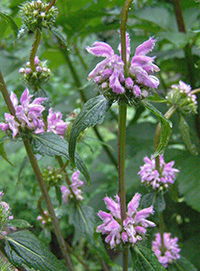Table of Contents
From the 16th century onwards, people believing the theory of signs saw the resemblance of an ill lung with tuberculosis in the Jerusalem sage plant. Many 19th and early 20th-century people suffering from tuberculosis were treated with the lungwort plant, sometimes achieving success. At present, it still is a helpful plant for respiratory afflictions.
No products found.

Jerusalem Sage Plant Scientific Facts
- Other names: Jerusalem cowslip, lungwort, maple lungwort, spotted comfrey, spotted lungwort.
- French: Pulmonaire.
- Spanish: Pulmonaria, salvia de Jerusalen.
- Environment: It is found in humid, clear, calcareous forests all over Europe and has been introduced to warm and cold regions of America.
- Description: This is a vibrant, herbaceous plant in the Boraginaceae family. Its hairy stem grows up to 30 cm high, and a pink and violet flower bouquet grows on the tip of its stem.
- Parts of the plant used medicinally: The whole plant with flowers.
Healing Properties and Indications

The whole plant contains mucilage and allantoin, both substances with emollient properties; tannin, with astringent properties; a certain amount of saponins, which give the plant expectorant properties; salicylic acid, and potassium and calcium salts, which have anti-inflammatory, diuretic, and sudorific properties.
- Internally used: The plant is recommended for several respiratory ailments, such as bronchial catarrh, sore throat, irritating cough, hoarseness, and aphonia (taken orally and in gargles). It is beneficial in combating the adverse effects of tobacco on the respiratory airways. It can be used for pulmonary tuberculosis to complement specific treatment, always under medical supervision.
- In external applications, the Jerusalem sage plant is used to heal wounds, bruises, skin marks, and chilblains.

How to use Jerusalem Sage
- Decoction with 30-50 g of plant per liter of water, boiled for 15 minutes. Drink three or four cups daily, sweetened with honey.
- Gargles with the same infusion as for internal use.
- Washing and compresses with the decoction mentioned above, applied on the affected skin area.
Frequently Asked Question
What are the primary bioactive compounds found within Jerusalem sage?
The plant contains an array of potentially beneficial compounds, including:
1. Flavonoids: Plant-based antioxidants like apigenin, luteolin, and quercetin.
2. Iridoids: Compounds such as aucubin and harpagide.
3. Diterpenoids: Including substances like fruticosin and fruticolone
4. Essential Oils: Complex mixtures with potential therapeutic effects.
Does research support the use of this plant for respiratory health?
While traditional use suggests a role in respiratory health, more human studies are needed. Preliminary research indicates:
1. Possible anti-inflammatory actions on airway tissues.
2. Potential as an expectorant, helping dislodge mucus.
Can it offer any benefits for the digestive system?
Folk medicine points to Jerusalem sage for soothing digestive upset. Limited studies suggest:
1. Iridoids from the plant may have anti-spasmodic effects, potentially reducing stomach cramps.
2. Possible mild laxative properties.
Could Jerusalem sage have antimicrobial properties?
Laboratory research indicates potential antimicrobial activity for components of Jerusalem sage: Essential oils may possess antibacterial and antifungal qualities.
Are there studies supporting the use of Jerusalem sage for wound healing?
Traditional medicine values its use on wounds, and some research offers promising insights: Animal studies suggest Jerusalem sage may promote wound healing processes.
Does Jerusalem sage have anti-inflammatory effects?
Evidence hints at potential anti-inflammatory properties:
1. Studies suggest flavonoids in the plant could reduce inflammation markers.
2. It can be used for mild inflammatory conditions.
Can Jerusalem sage provide pain relief?
Limited studies offer preliminary clues: Iridoids within Jerusalem sage may have some analgesic (pain-relieving) effects.
Are there established dosages for Jerusalem sage use?
There’s no standardized dosage due to limited clinical research. Traditional use varies widely – teas, tinctures, etc. Before taking Jerusalem sage for therapeutic purposes, seeking advice from a healthcare practitioner is crucial.
What are the potential side effects of Jerusalem sage?
Jerusalem sage is generally considered safe when used appropriately, but potential side effects include:
1. Mild digestive discomfort
2. Possible interactions with certain medications
3. Allergic reactions are possible, though rare.
Who should exercise caution or avoid using Jerusalem sage?
Precautions are necessary for:
1. Pregnant or breastfeeding women (lack of safety data)
2. Individuals taking medications (potential interactions)
3. Those with pre-existing medical conditions
DISCLAIMER: All content on this website is presented solely for educational and informational objectives. Do not rely on the information provided as a replacement for advice, diagnosis, or treatment from a qualified medical expert. If you are pregnant, nursing, or have any preexisting medical concerns, talk to your doctor before using any herbal or natural medicines.
REFERENCES
- George D. Pamplona-Roger, M.D. “Encyclopedia of Medicinal Plants.” George D. Pamplona-Roger, M.D. Encyclopedia of Medicinal Plants. Ed. Francesc X. Gelabert. Vols. 1 San Fernando de Henares: Editorial Safeliz, 2000. 331. Print.
- PubMed https://pubmed.ncbi.nlm.nih.gov/
- Google Scholar https://scholar.google.com/
- National Institutes of Health https://www.nih.gov/
- American Botanical Council http://abc.herbalgram.org/
Last update on 2024-07-20 / Affiliate links / Images from Amazon Product Advertising API





